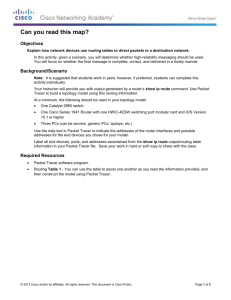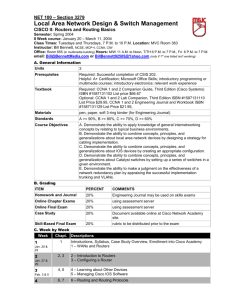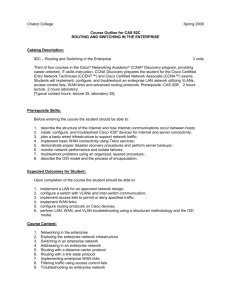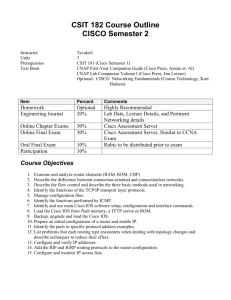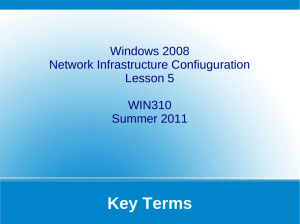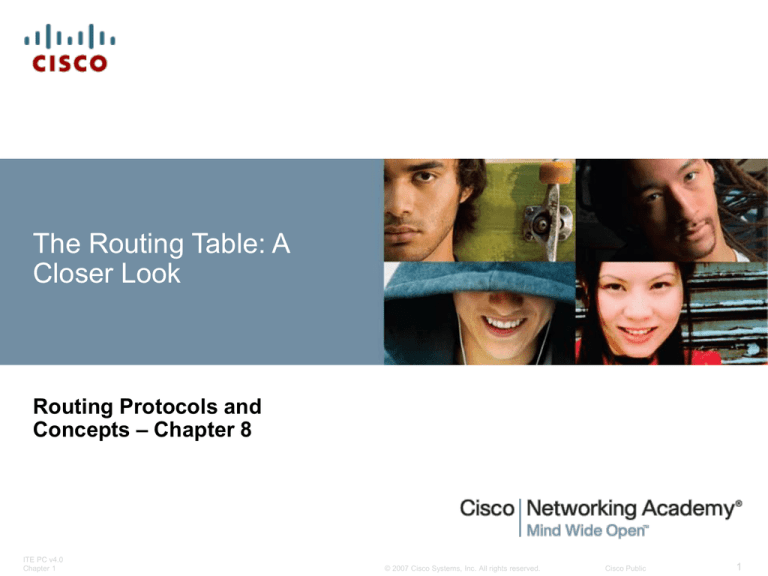
The Routing Table: A
Closer Look
Routing Protocols and
Concepts – Chapter 8
ITE PC v4.0
Chapter 1
© 2007 Cisco Systems, Inc. All rights reserved.
Cisco Public
1
Objectives
Describe the various route types found in the routing
table structure
Describe the routing table lookup process.
Describe routing behavior in routed networks.
ITE PC v4.0
Chapter 1
© 2007 Cisco Systems, Inc. All rights reserved.
Cisco Public
2
Introduction
Chapter Focus
-Structure of the routing table
-Lookup process of the routing table
-Classless and classful routing behaviors
ITE PC v4.0
Chapter 1
© 2007 Cisco Systems, Inc. All rights reserved.
Cisco Public
3
Routing Table Entries
Routing Table contains the following enteries:
Directly connected networks
Static routes
Dynamic routing protocols
The Cisco IP routing table is not a flat database. The routing table is
actually a hierarchical structure that is used to speed up the lookup
process when locating routes and forwarding packets. Within this
structure, the hierarchy includes several levels. For simplicity, we will
discuss all routes as one of two levels: level 1 or level 2.
ITE PC v4.0
Chapter 1
© 2007 Cisco Systems, Inc. All rights reserved.
Cisco Public
4
Level 1 Rotues
A level 1 route is a route with a subnet mask equal to or less than the
classful mask of the network address.
A level 1 route can function as a:
Default route
Supernet route
Network route - network route is a route that has a subnet mask equal to
that of the classful mask.
Ultimate route - The level 1 route can be further defined as an ultimate
route. An ultimate route is a route that includes:
either a next-hop IP address (another path)
and/or an exit interface
ITE PC v4.0
Chapter 1
© 2007 Cisco Systems, Inc. All rights reserved.
Cisco Public
5
Level 2 Routes
Routes with exit interface or next hop ip address are level 2
routes.
ITE PC v4.0
Chapter 1
© 2007 Cisco Systems, Inc. All rights reserved.
Cisco Public
6
Parent and Child route
Parent- A parent route is a network route that does not contain a next-hop IP
address or exit interface for any network. A parent route is actually a heading that
indicates the presence of level 2 routes, also known as child routes
Child -Child routes are also considered ultimate routes because they will
contain the next-hop IP address and/or exit interface.
ITE PC v4.0
Chapter 1
© 2007 Cisco Systems, Inc. All rights reserved.
Cisco Public
7
Routing Table Structure
Parent & Child Routes: Classless Networks
Network
Type
Parent route’s
Classful mask is
Displayed
Term
variably
subnetted
is seen in parent
route in routing
table
Classful
No
No
No
No
Classless
Yes
Yes
Yes
Yes
ITE PC v4.0
Chapter 1
Includes the Subnet mask
# of different
included
masks of
with each
child routes
child route
entry
© 2007 Cisco Systems, Inc. All rights reserved.
Cisco Public
8
Routing Table Structure
Parent & Child Routes: Classless Networks
ITE PC v4.0
Chapter 1
© 2007 Cisco Systems, Inc. All rights reserved.
Cisco Public
9
Route Lookup process
Step 1b.
If the best match is a level 1 parent route, proceed to Step 2.
Step 2.
The router examines child routes (the subnet routes) of the parent route for
a best match.
Step 2a.
If there is a match with a level 2 child route, that subnet will be used to
forward the packet.
ITE PC v4.0
Chapter 1
© 2007 Cisco Systems, Inc. All rights reserved.
Cisco Public
10
Conti..
Step 2b.
If there is not a match with any of the level 2 child routes, proceed to Step
3. Is the router implementing classful or classless routing behavior?
Step 3a.
Classful routing behavior: If classful routing behavior is in effect, terminate
the lookup process and drop the packet.
Step 3b.
Classless routing behavior: If classless routing behavior is in effect,
continue searching level 1 supernet routes in the routing table for a match,
including the default route, if there is one.
ITE PC v4.0
Chapter 1
© 2007 Cisco Systems, Inc. All rights reserved.
Cisco Public
11
Conti..
Step 4.
If there is now a lesser match with a level 1 supernet or default routes, the
router uses that route to forward the packet.
Step 5.
If there is not a match with any route in the routing table, the router drops
the packet.
ITE PC v4.0
Chapter 1
© 2007 Cisco Systems, Inc. All rights reserved.
Cisco Public
12
Routing Table Lookup Process
How a router finds a match with one of the level 2 child
routes
-First router examines parent routes for a match
-If a match exists then:
Child routes are examined
Child route chosen is the one with the
longest match
ITE PC v4.0
Chapter 1
© 2007 Cisco Systems, Inc. All rights reserved.
Cisco Public
13
Routing Behavior
Classful & classless routing protocols
Influence how routing table is populated
Classful & classless routing behaviors
Determines how routing table is searched after it is
filled
ITE PC v4.0
Chapter 1
© 2007 Cisco Systems, Inc. All rights reserved.
Cisco Public
14
Routing Behavior
Classful Routing
Behavior: no ip
classless
What happens if there is
not a match with any
level 2 child routes of the
parent?
-Router must determine if
the routing behavior is
classless or classful
-If router is utilizing classful
routing behavior then
-Lookup process is
terminated and
packet is dropped
ITE PC v4.0
Chapter 1
© 2007 Cisco Systems, Inc. All rights reserved.
Cisco Public
15
Routing Behavior
ip Classless
Beginning with IOS 11.3, ip classless was configured by
default
Classless routing behavior works for
-Discontiguous networks
And
-CIDR supernets
ITE PC v4.0
Chapter 1
© 2007 Cisco Systems, Inc. All rights reserved.
Cisco Public
16
Routing Behavior
Classless Routing Behavior: ip classless
Route lookup process when ip classless is in use
-If classless routing behavior in effect then
Search level 1 routes
Supernet routes Checked first
-If a match exists then forward packet
Default routes Checked second
If there is no match or no default
route then the
Packet is dropped
ITE PC v4.0
Chapter 1
© 2007 Cisco Systems, Inc. All rights reserved.
Cisco Public
17
Routing Behavior
Classful vs. Classless Routing Behavior
-It is recommended to use classless routing
behavior
Reason: so supernet and default routes can
be used whenever needed
ITE PC v4.0
Chapter 1
© 2007 Cisco Systems, Inc. All rights reserved.
Cisco Public
18
Summary
Content/structure of a routing table
Routing table entries
-Directly connected networks
-Static route
-Dynamic routing protocols
Routing tables are hierarchical
-Level 1 route
Have a subnet mask that is less than or equal to
classful subnet mask for the network address
-Level 2 route
These are subnets of a network address
ITE PC v4.0
Chapter 1
© 2007 Cisco Systems, Inc. All rights reserved.
Cisco Public
19
Summary
Routing table lookup process
Begins with examining level 1 routes for best match with packet’s destination IP
If the best match = an ultimate route then
-Packet is forwarded -Else-Parent route is examined
If parent route & destination IP match then Level 2 (child)
routes are examined
Level 2 route examination
If a match between destination IP and child route found then
Packet forwarded -Else
If Router is using classful routing behavior then
Packet is dropped -Else
If router is using classless routing behavior then
Router searches Level 1 supernet & default routes for a
match
If a match is found then Packet if forwarded -Else
Packet is dropped
ITE PC v4.0
Chapter 1
© 2007 Cisco Systems, Inc. All rights reserved.
Cisco Public
20
Summary
Routing behaviors
-This refers to how a routing table is searched
Classful routing behavior
-Indicated by the use of the no ip classless command
-Router will not look beyond child routes for a lesser
match
Classless routing behavior
-Indicated by the use of the ip classless command
-Router will look beyond child routes for a lesser match
ITE PC v4.0
Chapter 1
© 2007 Cisco Systems, Inc. All rights reserved.
Cisco Public
21
ITE PC v4.0
Chapter 1
© 2007 Cisco Systems, Inc. All rights reserved.
Cisco Public
22


